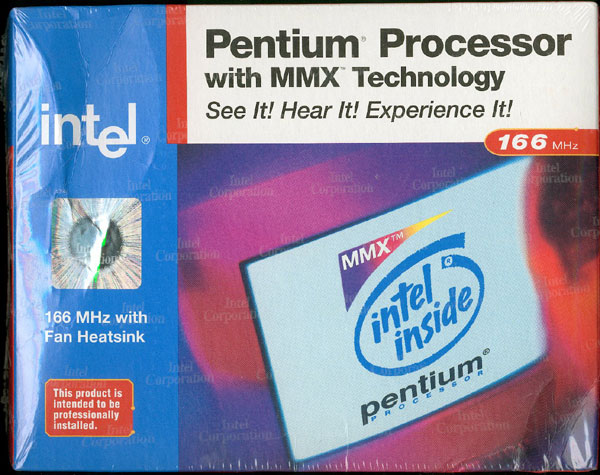Old technology is still a good upgrade
Intel Pentium MMX: Old technology is still a good upgrade
It’s not new, but it’s a cost effective upgrade for some users.
by Blake Linton Wilfong — The Wondersmith!
In my quest for improved game performance, I recently decided that my computer
desperately needed a processor upgrade. My computer’s Cyrix 6x86MX PR233 had an
Achilles heel: the floating point unit (FPU) was slow. This is unfortunate since
modern first person shooters (FPSs) need fast floating point operations for their 3D
geometry calculations, and Roger Wilco—the amazing voice-over-IP software that
lets you talk while you play—also makes heavy use of floating point for its voice
compression/decompression functions.
In contrast to the Cyrix 6x86MX, the Intel Pentium MMX has a pipelined FPU, which means it
can start the preliminaries of one floating point operation while it is finishing up another.
Thus, floating-point-intensive applications run faster on the Intel Pentium MMX than on the
Cyrix 6x86MX at the same clock speed/performance rating. Ditto for MMX operations.
What about the AMD K6-2? From what I’ve heard, its floating point and MMX performance lies
somewhere between that of the Cyrix 6x86MX and the Intel Pentium MMX. Its added 3D-Now!
instructions sometimes give it a boost over the Pentium MMX, but not all games support them.
The K6-2 is available at high clock speeds which should overcome any limitations of its
floating point and MMX units. But because these processors were introduced later than the
Intel Pentium MMX and Cyrix 6x86MX, they’re not compatible with the BIOS, voltage, and
slow clock speeds of older motherboards like the one in my computer.
For me, buying a new motherboard was out of the question. For one thing, the combined cost
of a quality motherboard and a high-speed AMD or Intel processor was more than I was
willing to spend. Besides, I’m just not competent to install a motherboard.
Besides, I’m just not competent to install a motherboard.
I found a nice new 233 MHz Intel Pentium MMX at a local computer store called
Chipsmart for just $46. (Yes, you can find it for
about $30 on Pricewatch—with a $15 shipping charge! I chose to buy locally so the chip would
be easy to exchange if it was DOA.) For once, installation was easy except that I was suprised
to see that the chip looked so «naked». Instead of a nice plastic cover, the top of the CPU
showed the exposed tops of the pins that plug into the socket, along with a metal case for the
silicon itself. With all that exposed metal, I was worried that my heat sink/fan would short
something out, so I called the store. The friendly fellow who answered assured me it was OK,
so I proceeded. Consulting the manual that came with my computer, I set the motherboard
jumpers for a 2.8 volt CPU core and 3.5X clock multiplier. When I booted up, the BIOS reported
that I had a 266 MHz Intel Pentium MMX.
Next, I—Wait a minute! 266 MHz? The Cyrix 6x86MX PR233 uses a 75 MHz external
clock frequency, not the 66 MHz that Intel intended for the 6x86MX. The 3.5X clock multiplier
increases the 75 MHz to 262.5 MHz, which the BIOS recognizes as 266. Sounds good to me!
Yup, I deliberately overclocked my processor, running it faster than its specificed maximum
speed rating. Be aware that Intel, like all other chipmakers, recommends against
overclocking. When overclocked, the CPU might fail sporadically, or might even suffer permanent
damage due to excess heat. Overclocking is downright dangerous, and if you do it you’re on your
own. On the other hand, Intel rates the maximum speed of its 233 MHz Pentium MMX rather
conservatively; this chip has an excellent record for overclocking to this speed,
and failures are rare. I gambled a little, knowing I might lose my $46 investment.
But after many days of heavy use, my computer is working perfectly.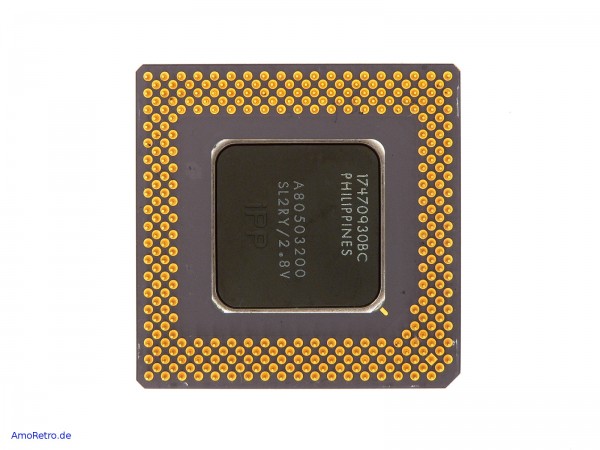 Now back to the story…
Now back to the story…
Next, I performed some benchmarks. Since I wanted to know just how much my processor has
improved things, I turned off my Voodoo3’s vertical sync so it wouldn’t be limited by my
monitor refresh rate. (By the way, I have confirmed that this makes no significant
difference at the slower frame rates my Cyrix processor produced, so my earlier benchmarks
with vertical sync turned on are valid for comparison.) GLQuake leaped from 35 fps to
70 fps, a 100% increase! Quake II jumped from 17 fps to 31 fps, an 82% increase! (These are
averages of several runs of the built-in demos.) It’s harder to judge exact numbers for
Roger Wilco, but from what I could tell, its average CPU utilization when encoding speech
dropped from around 50% to less than 25%—a speed boost of more than 100%! Subjectively,
Unreal is a lot smoother, GLQuake is totally smooth, and Quake II is also totally smooth
except for barely discernable slowdowns in extremely complex situations. Best of all, now that
Best of all, now that
my co-op gaming buddy has performed the same upgrade on his computer, Roger Wilco no longer
causes games to exhibit start-stop-start-stop behavior when we talk; there’s only a minor
hesitation here and there.
In conclusion, this is the best $46 I ever spent on an upgrade. The results have exceeded
my expectations. Owners of Cyrix 6x86MX-based (and maybe some AMD K6-2-based)
computers should consider it.
Is the overclocking really necessary? I also benchmarked two other configurations: the
standard 66 MHz x 3.5 = 233 MHz, and the slightly weird 75 MHz x 3 = 225 MHz. At 233 MHz,
GLQuake and Quake II yield 62 and 27 fps, respectively. At 225 MHz, GLQuake yields 64 fps
and Quake II runs at 28 fps. Huh? 225 MHz is faster than 233? Yes, because running
the whole computer system at a faster bus speed makes up for a slightly slower clock rate
inside the microprocessor. Similarly, at an external clock speed of 75 MHz, increasing the
CPU clock multiplier from 3 to 3. 5 and internal CPU speed from 225 MHz to 262.5—an increase
5 and internal CPU speed from 225 MHz to 262.5—an increase
of over 16%—resulted in an overall speed boost of only 8%. There are limits to how far you
can increase system performance simply by upshifting the clock rate of the processor alone.
Given this information, my conservative buddy decided to run his Pentium MMX at a safer
225 MHz, while I opted to go with the overclocked speed.
One final interesting observation: The id-sanctioned book Official Quake II
Strategies and Secrets has a section titled «Processor Wars» that describes the slowdowns
caused by the FPUs in K6 and 6x86MX processors. But it adds, «The good news is that this
deficiency does not affect the performance of GL rendering with a 3Dfx card installed.»
Wrongo! As I’ve mentioned, all my tests were done using a Voodoo3. Though the graphics
board can speed up many operations, there’s still plenty of floating point left to the FPU.
Moral: you can get misinformed even by a trustworthy source.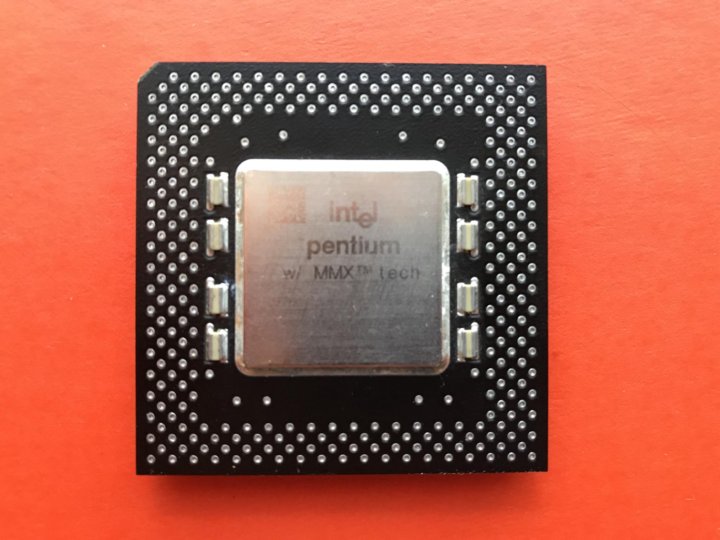
|
|
Return to the Rants, Raves, and Reviews main page |
Return to The World of the Wondersmith |
Rants, Raves, and Reviews
Copyright © 1999-2018 Blake Linton Wilfong
All rights reserved.
Prozessor Intel Pentium MMX 233 MHz (SL27S, 296-pin PPGA, 2,8V Vcore)
Prozessor Intel Pentium MMX 233 MHz (SL27S, 296-pin PPGA, 2,8V Vcore) FV80503233
If you are not sure whether the CPU offered here is suitable for your PC or motherboard, please ask before you buy.
| Processor Technical Specifications | |
| Brand | Intel |
| Part # | FV80503233 (SL27S) |
| Prozessor Type | Desktop |
| Series | Pentium MMX Processor |
| Processor Core | P55C |
| # of Cores | 1 |
| Level 1 cache size | 16 KB 4-way set associative code cache 16 KB 4-way set associative write-back data cache |
| CPU Socket Type | Socket 7 |
| Clock Speed | 233 MHz |
| Bus Speed | 66 MHz |
| Clock multiplier | 3. 5 5 |
| I/O Voltage | 3.3V |
| VCore Voltage | 2.8V |
| Extensions and Technologies | MMX instructions |
| Low power features |
|
| On-chip peripherals |
|
| Manufacturing Technology | 0.35 micron CMOS process, 4.5 million transistors |
| Cooling Device | No |
| Thermal Power | 17 W |
| Maximum operating temperature | 70°C |
Contact data
No title MsMr
Title — optional
First name
Last name
Company — optional
Phone — optional
Question about item
Your question
Contact data
Prices for Pentium processors have changed | Computerworld Russia
02/11/1997
Andy Santoni, Caroline A.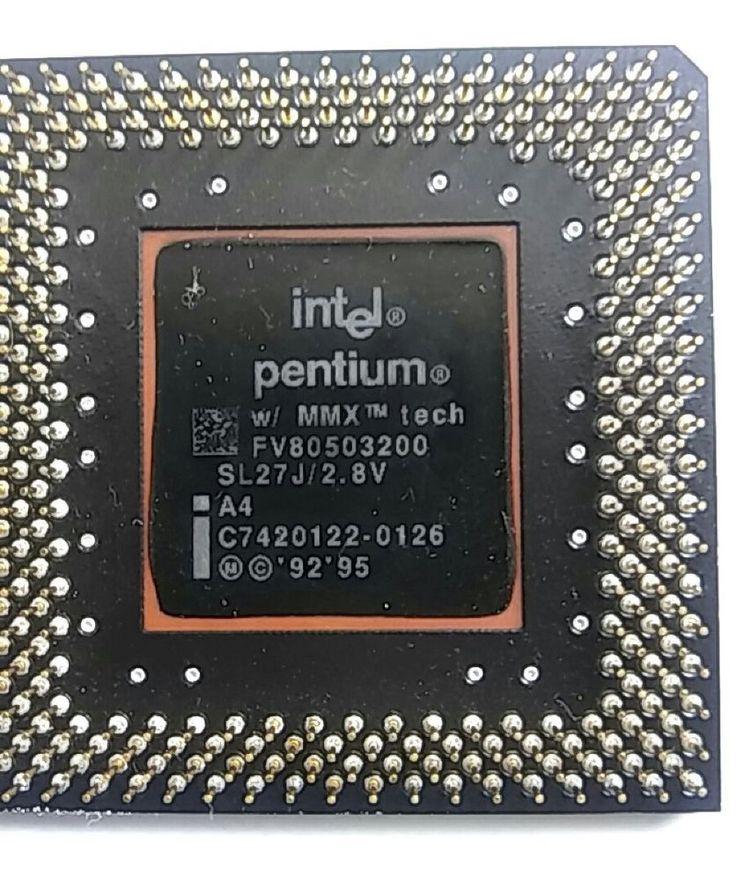 April
April
Category:Technology
Intel is back in the spotlight with its 166 MHz Pentium desktop and 150 MHz mobile Pentium systems. This was achieved thanks to price cuts, including those for Pentium processors with MMX technology, which were introduced only at the beginning of January.
However, the price cuts did not affect the high-performance Pentium Pro processors. The highest performing processor, the Pentium/200 MHz, was only 2% cheaper.
«If we take into account production volumes of Pentium Pro processors, it’s clear that they’re not high enough to warrant price cuts,» said John Dunkle, president of consulting firm Workgroup Strategic Services.
According to Michael Slater, publisher of the Microprocessor Report, Intel management’s decision was also influenced by low earnings.
Although Intel is not making the desired revenue from 200 MHz processors, the company may change its existing manufacturing technology and offer a 233 MHz desktop processor in the second quarter of this year.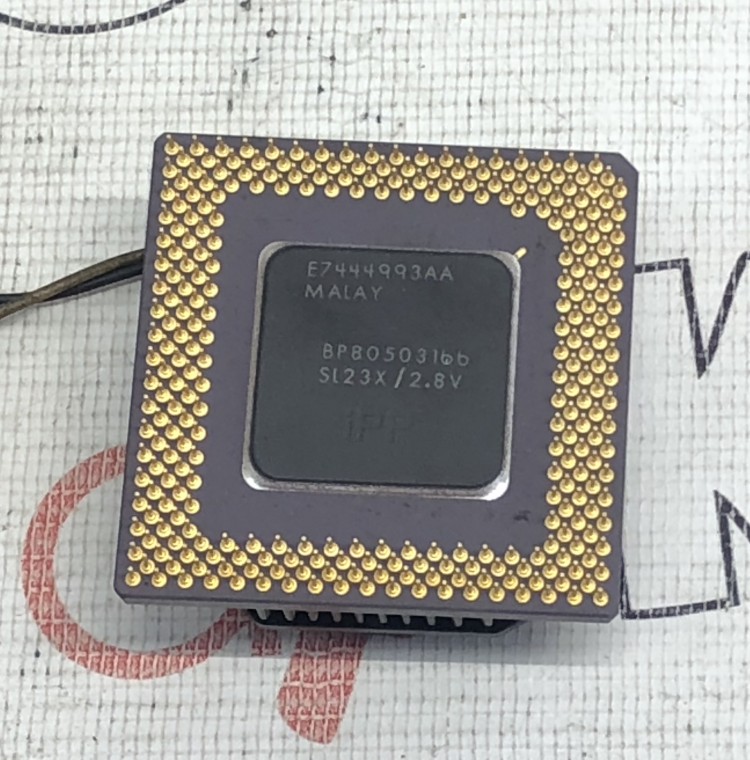 That’s the opinion of Linley Gwennap, editor-in-chief of the Microprocessor Report. Gwennap predicts that Pentium MMX/233 MHz, called Tillamook, created using a new «reduced» technology, can be installed in desktop versions in the second half of 1997, and in mobile computers — in 1998.
That’s the opinion of Linley Gwennap, editor-in-chief of the Microprocessor Report. Gwennap predicts that Pentium MMX/233 MHz, called Tillamook, created using a new «reduced» technology, can be installed in desktop versions in the second half of 1997, and in mobile computers — in 1998.
The most drastic price reduction by Intel was for the Pentium/166 MHz processor. Its cost decreased by 26.6%, from $402 to $295, and for Pentium/133 MHz — by 34.3%, from $204 to $134. 24.2%, from $443 to $336.
According to Richard Zvetchkenbaum, director of new consumer transmission technology research at IDC Link, OEMs intend to make similar price cuts on nearly all models.
Price cuts on microprocessors can lead to a reduction in the cost of PC systems within three weeks. And, first of all, from OEMs such as Dell, Gateway 2000 and Micron Electronics, working on an order system and leading direct sales. System vendors who sell their designs through distribution channels and VARs will be offering cheaper systems in the next two months, Dunkl said.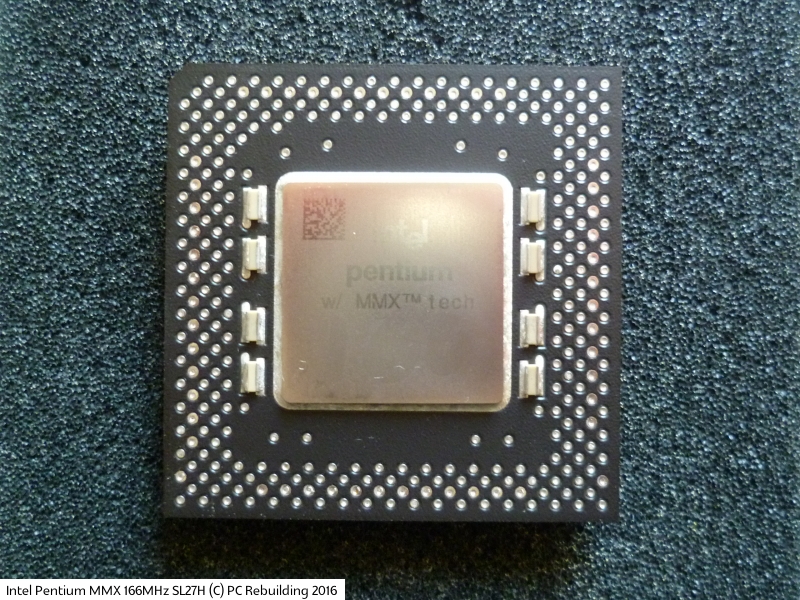
Intel can be contacted at: http://www.intel.com .
Intel lowers processor prices
|
|
|
|
|
|
|
|
|
|
|
|
|
|
|
|
|
|
|
|
|
|
|
|
|

Analysts agree that the price change is indicative of the company’s commitment to making its 166MHz Pentium the go-to processor for OEMs. In addition, they believe that Intel is seeking to increase sales of a new processor with MMX capabilities, which contains an additional instruction set to increase the speed and performance of graphics and multimedia applications. These processors were introduced on January 8th.
The history of Intel Pentium processors: legends of the nineties
Today, choosing and purchasing a processor is quite simple: just go to an online store (for example: processors) and place an order. But earlier, in the early nineties, they were sold only in rare computer equipment stores and were expensive. Let’s fast forward to that time together and remember Intel’s processors. The period from 1993 to 2002 was one of the best for Intel and a defining one for the entire computer industry as a whole. The development of technology went by leaps and bounds.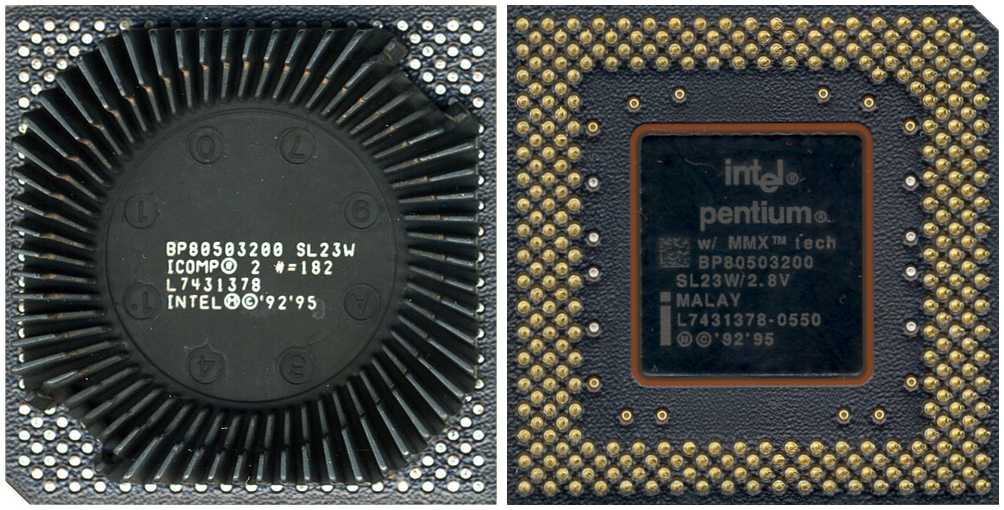 And the current situation on the market, in comparison with that one, is the “epoch of stagnation”. Today we are wondering which is better, AMD or Intel? In those days, there was no such question. Then Intel released many wonderful processors, which we will remember today thanks to elmir.ua …
And the current situation on the market, in comparison with that one, is the “epoch of stagnation”. Today we are wondering which is better, AMD or Intel? In those days, there was no such question. Then Intel released many wonderful processors, which we will remember today thanks to elmir.ua …
Pentium
- Frequency : 66 — 233 MHz
- Process : 800 — 280 nm
- Year of construction : 1993 – 1997
- Socket : Socket 4,5,7
It all started with the first «stump». He appeared in 1993 and made a splash in the processor market. Prior to this, i386 and i486 were copied by many companies. With its release, this era, which lasted 10 years, ended — Intel closed the architecture and platform with patents. Almost all competitors, except for AMD, left the market. And she began to develop her own processor.
Pentium II
- Frequency : 233 — 450 MHz
- Process : 350 – 250 nm
- Year of construction : 1997 – 1998
- Slot : Slot 1
Around 1995, the Pentium Pro appeared, which was no less revolutionary than the first «stump». It was built on the P6 architecture. Intel decided to bring this architecture to desktops. The result is the Pentium II. He had 2 generations: Klamath and Deshutes.
It was built on the P6 architecture. Intel decided to bring this architecture to desktops. The result is the Pentium II. He had 2 generations: Klamath and Deshutes.
Then Intel faced a big problem — the price. The cheapest Pentium cost from $500. This amount was lifting only for 20% of users. In order to reduce the cost of the Pentium II, it was transferred to a new type of case — a slot-cartridge. The bottom line was that the core was installed on a piece of textolite, which was inserted into the slot. True, this did not give results in the future. Starting from this period, the L2 cache problem appeared. If in the first «stump» it was on the motherboard, and in Pro in the form of a second crystal, then in the second it was on separate microcircuits. The problem is that it worked only at half the processor frequency, which greatly affected its speed.
Pentium III
- Frequency : 500 — 1400 MHz
- Process : 250 — 130 nm
- Year of construction : 1999 – 2002
- Socket : Slot 1/Socket 370
The Pentium III was released after the kernel was improved and SSE instructions were added.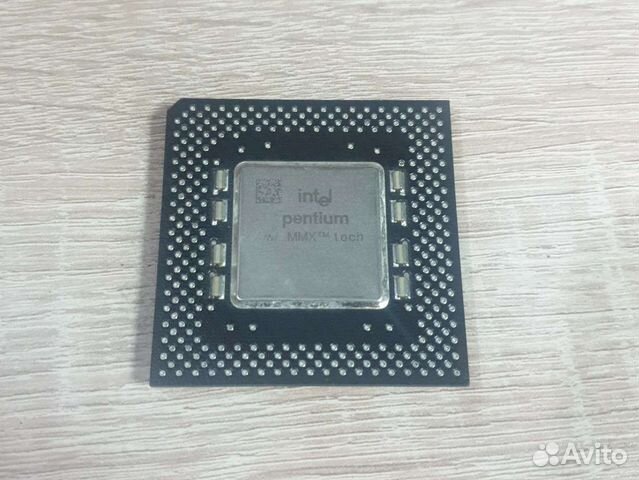 In fact, it almost did not differ from its predecessor, but it managed to «wipe its nose» at AMD’s Athlon XP. It had 3 generations: Katmai, Coppermine and Tualatin.
In fact, it almost did not differ from its predecessor, but it managed to «wipe its nose» at AMD’s Athlon XP. It had 3 generations: Katmai, Coppermine and Tualatin.
One of the most important improvements was moving the L2 cache to the core (Coppermine and Tualatin), which significantly speeded up its work, but the volume decreased by 2 times. Starting with the Coppermine core, a new connector appeared — Socket 370 (BGA package), which was much cheaper than Slot 1. But for those who did not want to change the platform when upgrading their PC, special adapters were created that extended the life of the old platform by 2 years .
It was with the third “hump” that Intel reached the milestone of 1 GHz. But further raising the frequencies made the processor unstable (the technical process that had exhausted its resource interfered). The peak of development was the core of Tualatin, where all the juices were squeezed out of that platform. The processor turned out to be so successful that it bypassed the first fourth “stumps”.